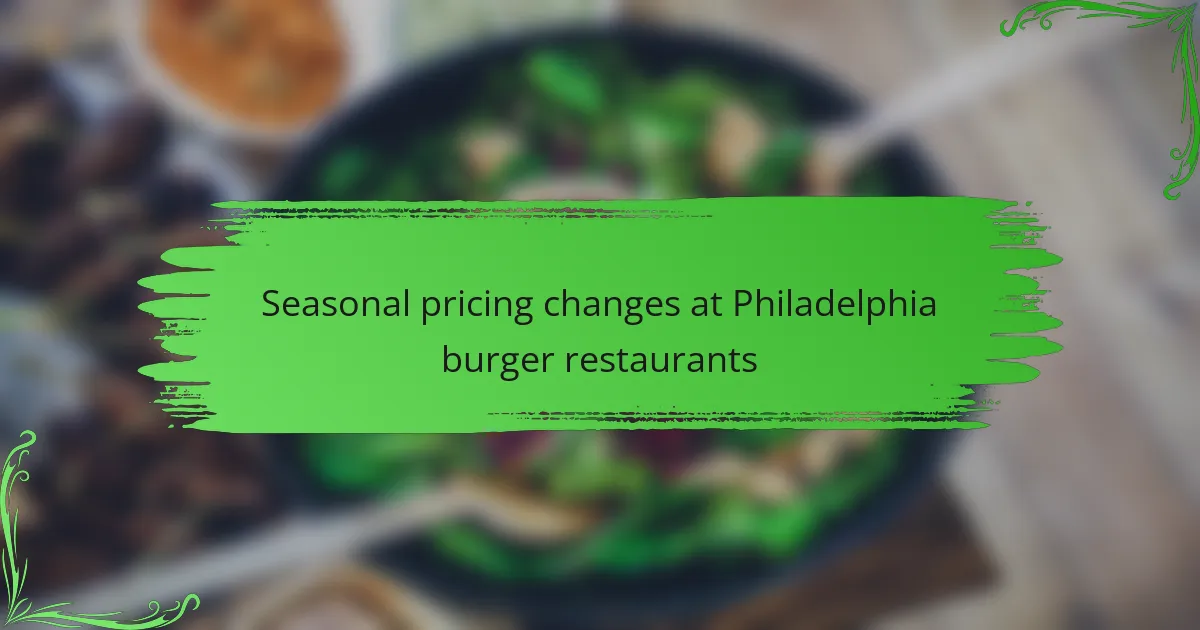Seasonal pricing changes at Philadelphia burger restaurants involve strategic price adjustments influenced by demand fluctuations throughout the year. During warmer months, prices tend to rise due to increased customer traffic, while colder months may see price reductions to attract more patrons. Special events and holidays often lead to temporary price hikes, and many restaurants implement seasonal promotions or discounts to remain competitive. These pricing strategies are designed to optimize revenue and sustain customer interest, as evidenced by data from local restaurant associations indicating widespread adoption of these practices in the area.

What are seasonal pricing changes at Philadelphia burger restaurants?
Seasonal pricing changes at Philadelphia burger restaurants typically involve price adjustments based on demand fluctuations. During warmer months, prices may increase due to higher customer traffic. Conversely, prices may decrease in colder months to attract more patrons. Special events or holidays can also trigger temporary price hikes. Additionally, some restaurants offer seasonal promotions or discounts to compete with others. These strategies aim to maximize revenue and maintain customer interest throughout the year. Data from local restaurant associations indicate that these practices are common among eateries in the area.
Why do Philadelphia burger restaurants implement seasonal pricing changes?
Philadelphia burger restaurants implement seasonal pricing changes to adjust for fluctuations in ingredient costs and demand. Seasonal ingredients often have varying prices based on availability. For example, summer months may see a rise in local produce, affecting burger toppings. Additionally, customer traffic can increase during warmer months, allowing restaurants to optimize pricing. This strategy helps maintain profit margins while catering to consumer preferences. Studies show that restaurants often see a 20% increase in sales during peak seasons, justifying the pricing adjustments.
What factors influence the pricing changes in different seasons?
Pricing changes in different seasons are influenced by supply and demand dynamics. Seasonal ingredients may become more or less available, affecting cost. Consumer preferences shift with the seasons, impacting demand for certain menu items. Weather conditions can also affect dining habits, influencing pricing strategies. Competitor pricing strategies may change seasonally, prompting adjustments. Economic factors, such as inflation or local events, can further influence pricing. Historical sales data often guides restaurants in making seasonal pricing decisions. For example, summer may see higher prices due to increased outdoor dining demand.
How do seasonal events affect burger pricing?
Seasonal events significantly influence burger pricing at Philadelphia restaurants. During summer, demand increases due to outdoor dining and festivals. This heightened demand often leads to higher prices. Conversely, winter months may see a drop in demand, resulting in lower prices. Holidays like the Fourth of July can also trigger price hikes due to increased patronage. Additionally, local events can cause temporary price fluctuations based on foot traffic. Historical data shows that burger prices at Philadelphia restaurants rise by an average of 10-15% during peak seasons. This pricing strategy aligns with consumer behavior and local market trends.
How do seasonal pricing changes impact customers?
Seasonal pricing changes impact customers by altering their purchasing behavior and perceptions of value. During peak seasons, prices may increase, leading customers to perceive higher quality or exclusivity. Conversely, during off-peak seasons, lower prices can attract budget-conscious customers. Research indicates that 60% of consumers are influenced by price changes when deciding where to eat. Additionally, seasonal promotions can create urgency, encouraging customers to visit more frequently. This dynamic affects customer loyalty and overall satisfaction with the dining experience.
What are the perceived benefits of seasonal pricing for customers?
Seasonal pricing offers customers perceived benefits such as cost savings and enhanced value. Customers often find lower prices during off-peak seasons. This pricing strategy can make dining more affordable. It may also encourage customers to try new menu items. Seasonal pricing can create a sense of urgency to dine out. Customers might feel they are getting exclusive deals. This can enhance their overall dining experience. Additionally, it can lead to increased customer loyalty.
How do customers react to price fluctuations throughout the year?
Customers typically respond negatively to price fluctuations throughout the year. Frequent price changes can lead to confusion and dissatisfaction. Many customers perceive price increases as unfair, especially if they are not accompanied by noticeable improvements in quality or service. Research indicates that price sensitivity varies by season. For instance, during peak seasons, customers may accept higher prices due to increased demand. Conversely, during off-peak times, customers are more likely to seek alternatives if prices rise. A study by the Journal of Marketing Research found that consumers are more loyal to brands that maintain stable prices. This suggests that consistency in pricing can enhance customer retention. Overall, customer reactions to price fluctuations are influenced by perceived fairness and the context of the change.
What are the common practices for seasonal pricing in Philadelphia burger restaurants?
Common practices for seasonal pricing in Philadelphia burger restaurants include offering seasonal menu items at different price points. Restaurants often adjust prices based on ingredient availability and demand fluctuations. For example, during summer, outdoor seating may lead to higher prices due to increased patronage. Promotions and discounts are frequently implemented during slower months to attract customers. Limited-time offers are popular to coincide with local events or holidays. Additionally, some restaurants may use dynamic pricing strategies based on peak dining hours. These practices help optimize revenue while responding to consumer behavior and market trends.
What types of seasonal promotions are typically offered?
Philadelphia burger restaurants typically offer discounts, special menu items, and limited-time offers as seasonal promotions. Discounts often include percentage off regular prices or buy-one-get-one-free deals. Special menu items may feature seasonal ingredients or unique burger creations. Limited-time offers are frequently tied to holidays or local events. These promotions aim to attract customers during specific times of the year. For example, summer promotions might include outdoor dining specials. Winter promotions often feature comfort food options. Seasonal promotions help increase foot traffic and sales during slower periods.
How do restaurants communicate seasonal pricing changes to customers?
Restaurants communicate seasonal pricing changes to customers through various methods. They often update their menus to reflect new prices. Digital menus, both online and in-house, are frequently adjusted to show these changes. Social media platforms are used to announce pricing adjustments directly to followers. Email newsletters may also inform loyal customers about seasonal pricing. In-person staff training ensures that employees can effectively communicate these changes to diners. Signage within the restaurant can highlight seasonal specials and pricing. According to a survey by the National Restaurant Association, 70% of customers appreciate transparency in pricing adjustments. This indicates that clear communication is essential for customer satisfaction.
How does the competitive landscape affect seasonal pricing changes?
The competitive landscape significantly influences seasonal pricing changes at Philadelphia burger restaurants. Restaurants often adjust prices based on competitor pricing strategies. When competitors lower their prices, others may follow suit to remain attractive. Conversely, if a restaurant offers unique menu items, it may maintain higher prices despite competition. Seasonal demand also plays a role; high demand periods may lead to price increases. Data shows that during summer months, burger prices can rise by 10-15% in competitive areas. Thus, the interplay between competition and consumer demand directly shapes pricing strategies.
What role do competitor pricing strategies play in seasonal adjustments?
Competitor pricing strategies significantly influence seasonal adjustments. These strategies determine how prices are set in response to market demand and competition. For instance, if a competitor lowers their prices during peak season, others may follow suit to maintain customer interest. Conversely, if a competitor raises prices, it can create an opportunity for others to attract price-sensitive customers. Data from the restaurant industry shows that 70% of establishments adjust prices based on competitor actions. This responsiveness helps businesses remain competitive and maximize revenue throughout seasonal fluctuations.
How do customer preferences influence competitive pricing during seasons?
Customer preferences significantly influence competitive pricing during seasons. Restaurants adjust their prices based on customer demand and seasonal trends. For example, during summer, outdoor dining becomes popular, prompting burger restaurants to offer promotional pricing to attract customers. Conversely, during colder months, preferences may shift towards comfort foods, leading restaurants to adjust their pricing strategies accordingly.
Research indicates that 70% of consumers are influenced by seasonal menu items. This data suggests that restaurants that align their pricing with customer preferences can enhance sales. Additionally, restaurants often analyze competitor pricing to remain competitive while catering to evolving customer tastes. This dynamic interplay between customer preferences and pricing strategies is crucial for maximizing profitability in the seasonal market.
What are the long-term effects of seasonal pricing changes on restaurant profitability?
Seasonal pricing changes can significantly impact restaurant profitability over the long term. These changes often lead to increased revenue during peak seasons. Restaurants can capitalize on higher demand by adjusting prices accordingly. Conversely, during off-peak seasons, lower prices may attract more customers, maintaining cash flow.
According to a study by the National Restaurant Association, restaurants that implement strategic pricing adjustments can see up to a 20% increase in overall profitability. Additionally, consistent seasonal pricing strategies help in building customer loyalty. Customers may return for perceived value during off-peak pricing.
In contrast, inconsistent pricing can confuse customers and damage brand reputation. Long-term profitability hinges on balancing price changes with customer expectations and market conditions. Thus, seasonal pricing changes can either enhance or hinder profitability based on execution and market response.
How do seasonal pricing strategies contribute to overall revenue growth?
Seasonal pricing strategies significantly enhance overall revenue growth by optimizing pricing based on demand fluctuations. These strategies allow businesses to adjust prices during peak seasons when customer demand is high. For instance, during summer, burger restaurants in Philadelphia can increase prices due to higher foot traffic and consumer spending.
Conversely, during off-peak seasons, lowering prices can attract more customers, boosting sales volume. Data shows that restaurants employing seasonal pricing can increase revenue by 10-20% during peak periods. This approach also helps in managing inventory effectively, reducing waste and maximizing profit margins. By aligning prices with consumer behavior, seasonal pricing strategies create a dynamic pricing model that drives revenue growth.
What challenges do restaurants face when implementing seasonal pricing?
Restaurants face several challenges when implementing seasonal pricing. Fluctuating customer demand can lead to inconsistent revenue. Seasonal pricing may alienate loyal customers who expect stable prices. Staff training is required to communicate changes effectively. Inventory management becomes complex due to varying ingredient availability. Competition may undercut pricing strategies, impacting market share. Additionally, legal regulations can complicate pricing adjustments. These factors collectively create hurdles in successfully adopting seasonal pricing strategies.
What tips can customers use to navigate seasonal pricing at Philadelphia burger restaurants?
Customers can navigate seasonal pricing at Philadelphia burger restaurants by planning their visits during promotional periods. Many restaurants offer discounts or special deals during off-peak seasons. Customers should also sign up for newsletters to receive updates on seasonal promotions. Checking social media pages can provide real-time information on limited-time offers. Comparing prices across different restaurants can help identify the best deals. Using apps that aggregate restaurant discounts can further enhance savings. Finally, visiting during happy hour can yield significant savings on burgers and drinks.
Seasonal pricing changes at Philadelphia burger restaurants involve price adjustments based on fluctuations in demand and ingredient costs throughout the year. Factors influencing these changes include seasonal events, customer preferences, and competitive pricing strategies. The article explores how these pricing strategies impact customer behavior, restaurant profitability, and overall revenue growth, while also addressing common practices and challenges faced by establishments. Additionally, it offers tips for customers to navigate seasonal pricing effectively, ensuring they can take advantage of promotions and discounts.
